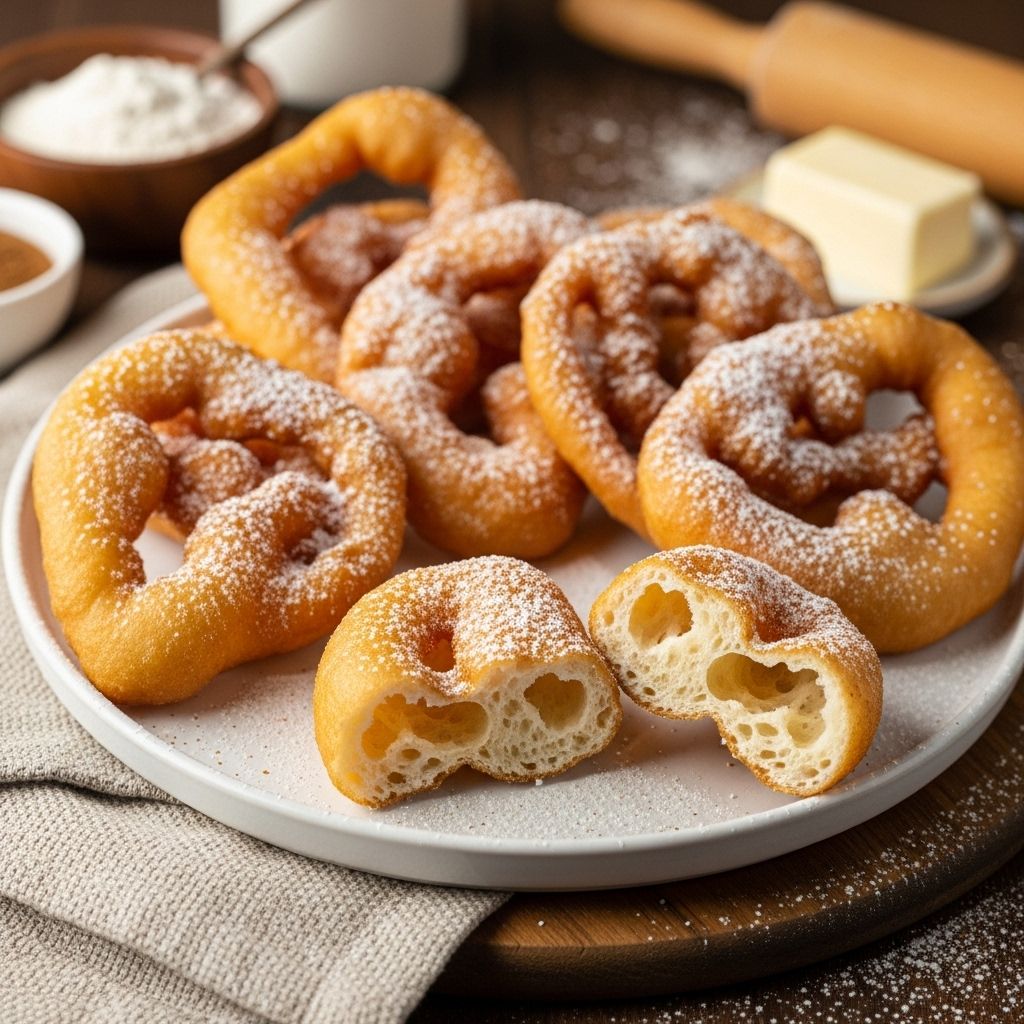Homemade Elephant Ears Recipe: Easy Step-By-Step Guide
Experience the nostalgic magic of crispy, golden Elephant Ears—your favorite fairground sweet—fresh from your own kitchen.

Image: HearthJunction Design Team
Elephant Ears: The Classic Fair Treat Made Easy at Home
If there’s one treat that instantly transports you to a bustling fairground or a joyful carnival, it’s the iconic Elephant Ear. These giant, golden sheets of crisp-fried dough, showered with cinnamon sugar, are a beloved indulgence for kids and adults alike. Making Elephant Ears at home is surprisingly simple and a fantastic way to bring the festive spirit of the state fair right to your kitchen. In this article, you’ll find a comprehensive guide to making Elephant Ears from scratch, including classic recipes, topping ideas, expert tips, nutrition facts, and answers to your most frequently asked questions.
What Are Elephant Ears?
Elephant Ears are large, thin disks of sweetened dough, deep-fried until puffed and crispy, and generously coated with cinnamon sugar. Their whimsical name comes from their playful resemblance to the broad ears of an elephant. While often found at county fairs, carnivals, and amusement parks, you can easily recreate this festive favorite at home with just a handful of pantry staples.
Essential Ingredients for Elephant Ears
The beauty of Elephant Ears lies in their simplicity. Here are the classic ingredients you’ll need:
- Milk: Adds richness and helps develop a tender dough.
- Shortening: Provides a soft texture; you can substitute with butter or margarine.
- Sugar: Sweetens the dough and the final coating.
- Salt: Balances flavors.
- Active Dry Yeast: Makes the dough light and fluffy.
- All-Purpose Flour: Forms the structure of the dough.
- Oil for Frying: A neutral oil such as vegetable or canola works best.
- Cinnamon Sugar: The signature topping, blending ground cinnamon with granulated sugar.
Typical Proportions (for about 8 Elephant Ears):
- 1 1/2 cups milk
- 3/8 cup shortening (about 6 tablespoons)
- 2 tablespoons white sugar
- 1 teaspoon salt
- 2 tablespoons active dry yeast
- 4 cups all-purpose flour
- Oil for frying
- 1/4 cup ground cinnamon + 2 cups sugar for topping
How to Make Elephant Ears: Step-by-Step Instructions
Making Elephant Ears is straightforward, but following each stage ensures a tender, golden result. Here’s a detailed walk-through:
1. Prepare the Dough
- In a small saucepan over medium heat, combine the milk, salt, sugar, and shortening. Cook until the shortening melts and the sugar dissolves, stirring frequently. Remove from heat and cool until lukewarm.
- In a large mixing bowl, dissolve the active dry yeast in a few tablespoons of the lukewarm milk mixture. Let stand until frothy (about 5 minutes).
- Add the remaining milk mixture to the yeast.
- Gradually stir in the flour (about 1 cup at a time), mixing until a soft dough forms.
- Knead the dough on a lightly floured surface for several minutes until smooth and elastic.
- Place dough in a greased bowl, cover with a damp towel or plastic wrap, and let it rise in a warm place until doubled in size (around 1 hour).
2. Shape & Roll Out the Dough
- Punch down the dough and divide it into 4 to 8 equal-sized balls (depending on how large you want your Elephant Ears).
- On a lightly floured surface, roll each portion into a thin sheet, roughly 1/4-inch thick and 8 to 10 inches in diameter. Don’t worry if they’re not perfectly round—they’re meant to look rustic!
3. Heat the Oil & Fry
- Pour 1-2 inches of oil into a deep skillet or heavy-bottomed pot. Heat the oil to 375°F (190°C).
- Carefully place one rolled dough sheet into the hot oil. Fry for 30 seconds to 2 minutes per side, flipping with tongs, until puffed and golden brown.
- Remove the elephant ear with tongs and drain briefly on paper towels.
4. Cinnamon Sugar Coating
- While the Elephant Ear is still warm, lavishly dust both sides with the cinnamon and sugar mixture. The warmth helps the sugar adhere.
- Repeat the process with the remaining dough.
Tips for Perfect Elephant Ears
- Don’t Overcrowd the Pan: Fry one Elephant Ear at a time to maintain the oil temperature and ensure even frying.
- Oil Temperature Matters: Use a thermometer if possible; too cool and the dough will soak up oil, too hot and it may burn.
- Thin Dough = Crispier Ears: Roll dough as thin as possible for that signature crispy crunch.
- Serve Immediately: Elephant Ears are best enjoyed hot and fresh.
- Have Fun: No need to stress about perfect shape—irregular, whimsical shapes add to the charm.
Variations & Toppings
While the classic version is dusted simply with cinnamon sugar, Elephant Ears are endlessly customizable. Try these fun ideas:
- Powdered Sugar: For a lighter, sweeter touch, dust with confectioners’ sugar.
- Chocolate Drizzle: Drizzle melted chocolate or Nutella over the warm dough.
- Fruit Compote: Top with strawberries, cherries, or apple pie filling for a decadent twist.
- Cream Cheese Glaze: Spread a layer of sweetened cream cheese frosting for a rich treat.
- Savory Twist: Omit the sugar and cinnamon, and sprinkle with Parmesan and herbs for a savory snack.
Nutrition Facts
| Serving Size | Calories | Carbohydrates | Protein | Fat | Sodium |
|---|---|---|---|---|---|
| 1 Elephant Ear | Approx 250 | ~36g | ~4g | ~10g | ~230mg |
Note: Values are approximate and will vary based on size, toppings, and frying oil absorbed.
Frequently Asked Questions (FAQs)
What’s the difference between Elephant Ears and Funnel Cake?
Elephant Ears are made from a yeast-based dough that’s rolled thin and fried, resulting in a large, flat, crispy treat. Funnel Cake uses a pourable batter that’s drizzled directly into hot oil, creating a lacy, craggy texture. Both are fairground classics, but the texture and process set them apart.
Can I make Elephant Ears without yeast?
Yes! You can make a quick version using baking powder instead of yeast. The results will be slightly less chewy and more similar to fried tortillas, but still delicious. Simply substitute 2 teaspoons of baking powder for the yeast and omit the proofing/rising stages.
How do I store leftover Elephant Ears?
Elephant Ears are best served fresh, but you can store leftovers in an airtight container at room temperature for up to 1 day. Reheat briefly in the oven to restore crispness. Avoid the microwave, as it can make them soggy.
Can I freeze dough for later?
Yes! Prepare the dough, let it rise, then divide it into balls, wrap each tightly, and freeze for up to 3 weeks. Thaw in the refrigerator overnight, then proceed with rolling and frying as usual.
What’s the best oil for frying?
Use a neutral oil with a high smoke point, such as vegetable, canola, or peanut oil, for best results.
Serving Suggestions
- Serve Elephant Ears with a cold glass of milk or lemonade for a nostalgic treat.
- Offer a toppings bar with chocolate, caramel, chopped nuts, and fresh fruit for a customizable dessert experience.
- Pair with ice cream for a true fairground-inspired sundae.
Helpful Hints & Troubleshooting
- Dough too sticky? Add flour a tablespoon at a time until manageable, but don’t over-flour or the result will be tough.
- Dough won’t rise? Ensure your yeast is fresh and the milk mixture is lukewarm (not hot).
- Browning too quickly? Lower the oil temperature slightly to avoid burning the outside before the inside cooks through.
Fun Facts About Elephant Ears
- Similar treats can be found around the world, such as buñuelos in Spain and Latin America, langos in Hungary, and fry bread among Native American cultures.
- The name “Elephant Ear” refers to the shape, but you might also hear them called Beaver Tails in Canada.
- In many cultures, fried dough is a festive food enjoyed during celebrations and holidays.
Conclusion: Bring the Fair Home
Creating Elephant Ears at home is not only easy but also incredibly rewarding, filling your kitchen with the aromas and joy of a country fair. With just a few simple ingredients and a little bit of frying, you can indulge in a crispy, cinnamon-sugar delight that will satisfy every sweet tooth. Try out the classic version, experiment with toppings, and make this treat your own—no ticket required!
Printable Recipe Card: Classic Elephant Ears
- Prep Time: 20 minutes (plus rising)
- Cook Time: 15 minutes
- Total Time: 1 hour 35 minutes
- Yield: 4-8 servings
- In a small saucepan, heat 1 1/2 cups milk, 2 tablespoons sugar, 3/8 cup shortening, and 1 teaspoon salt until melted and dissolved. Cool to lukewarm.
- Dissolve 2 tablespoons active dry yeast in a few tablespoons of the milk mixture. Let stand until frothy.
- Combine milk mixtures, add 4 cups flour gradually, and knead until smooth.
- Let rise until doubled, about 1 hour.
- Divide, roll thin, and fry in 375°F oil until golden on each side.
- Drain, then dust generously with cinnamon sugar while warm. Serve immediately.
References
- https://www.allrecipes.com/recipe/20989/elephant-ears/
- https://www.allrecipes.com/article/how-to-make-elephant-ears/
- https://www.youtube.com/watch?v=dfUcmgFgYv4
- https://www.eatingonadime.com/easy-elephant-ears-recipe/
- https://www.indianapolismonthly.com/food-and-drinks/recipes/recipe-state-fair-elephant-ears/
Read full bio of medha deb












